Starting your own strawberry garden can be a fun and rewarding experience! This tutorial will guide you through the simple steps needed to plant, care for, and harvest ripe, juicy strawberries right from your backyard. Let’s jump right in and get those strawberries growing!
Pruning and Training Strawberry Plants
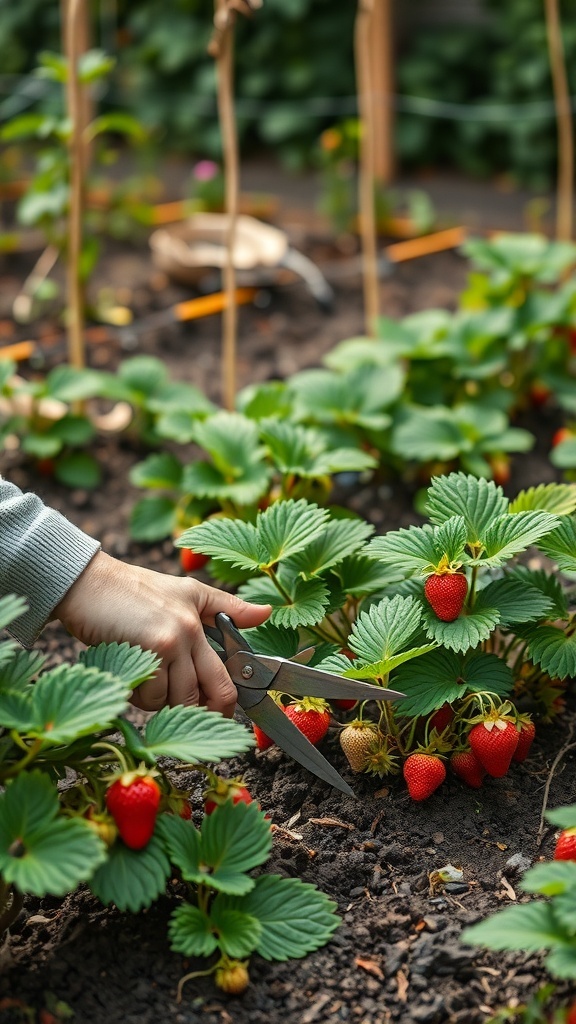
Pruning strawberry plants is key to keeping them healthy and productive. In the image, you can see someone carefully trimming the plants. This is an important step to encourage new growth and improve air circulation.
Start by removing any dead or yellowing leaves. This helps the plant focus its energy on producing fruit. You can also cut back runners, which are the long stems that grow out from the main plant. While these can create new plants, they can also take energy away from fruit production.
Training your strawberry plants is another great way to maximize your harvest. Using stakes or trellises can help keep the plants upright. This makes it easier to access the fruit and can help prevent rot from soil contact.
Remember to check your plants regularly. Keeping them tidy will not only make your garden look nice but will also lead to a better yield. Happy gardening!
Managing Pests and Diseases
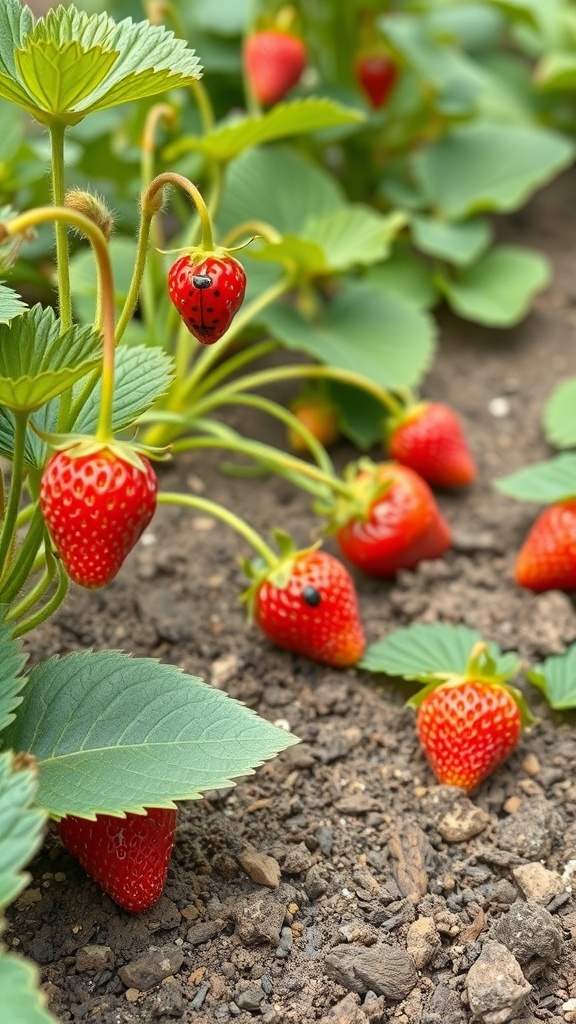
Growing strawberries can be a rewarding experience, but it comes with its share of challenges. Pests and diseases can sneak in and ruin your hard work. Keeping an eye on your plants is key to catching any issues early.
In the image, you can see vibrant strawberries nestled among lush green leaves. These plants are beautiful, but they can attract unwanted visitors like aphids and spider mites. Regularly inspecting your plants helps you spot these pests before they cause damage.
Another common issue is fungal diseases, which can thrive in damp conditions. To prevent this, ensure your plants have good airflow and avoid overhead watering. If you notice any signs of disease, like wilting leaves or unusual spots, act quickly to treat them.
Using natural remedies can be effective. For example, a mixture of water and dish soap can help control pests without harming your strawberries. Always test any solution on a small area first to ensure it won’t damage your plants.
By staying vigilant and using these simple techniques, you can keep your strawberry garden healthy and thriving. Happy gardening!
Mulching for Moisture Retention
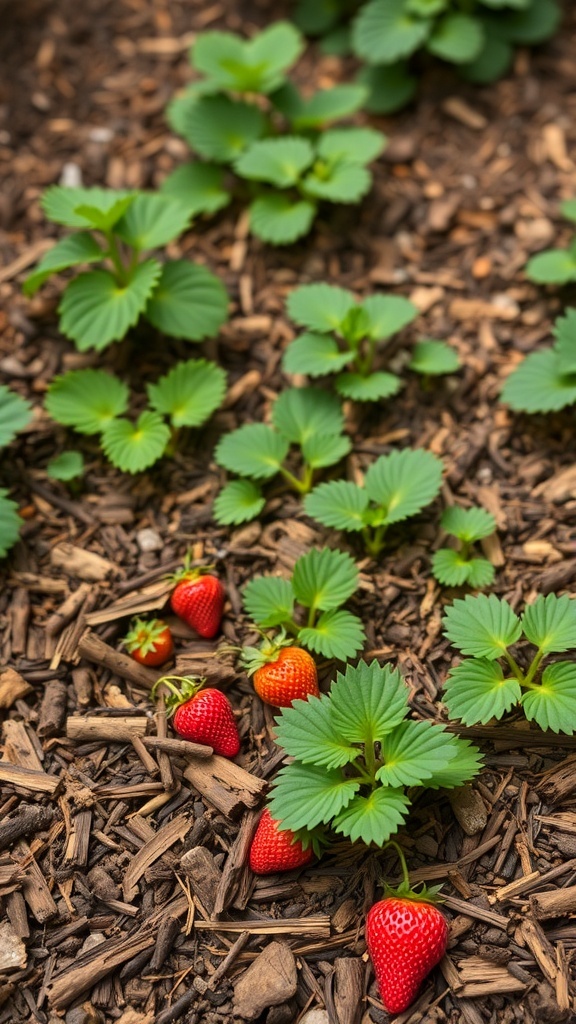
Mulching is a simple yet effective way to keep your strawberry garden thriving. In the image, you can see vibrant green strawberry plants surrounded by a layer of mulch. This setup not only looks neat but also serves a practical purpose.
The mulch helps retain moisture in the soil. Strawberries need consistent moisture to grow juicy and sweet. When you apply mulch, it acts like a blanket, preventing water from evaporating quickly. This means less frequent watering for you!
Another benefit of mulch is weed control. Weeds can compete with your strawberries for nutrients and water. By covering the soil with mulch, you reduce the chances of weeds sprouting up. This keeps your plants healthy and happy.
Using organic mulch, like wood chips or straw, can also improve soil quality as it breaks down over time. So, not only are you protecting your plants, but you’re also enriching the soil for future growth.
In summary, mulching is a great practice for anyone looking to grow strawberries. It saves time, conserves water, and promotes healthy plants. So grab some mulch and give your strawberry garden the care it deserves!
Optimal Planting Techniques for Strawberries
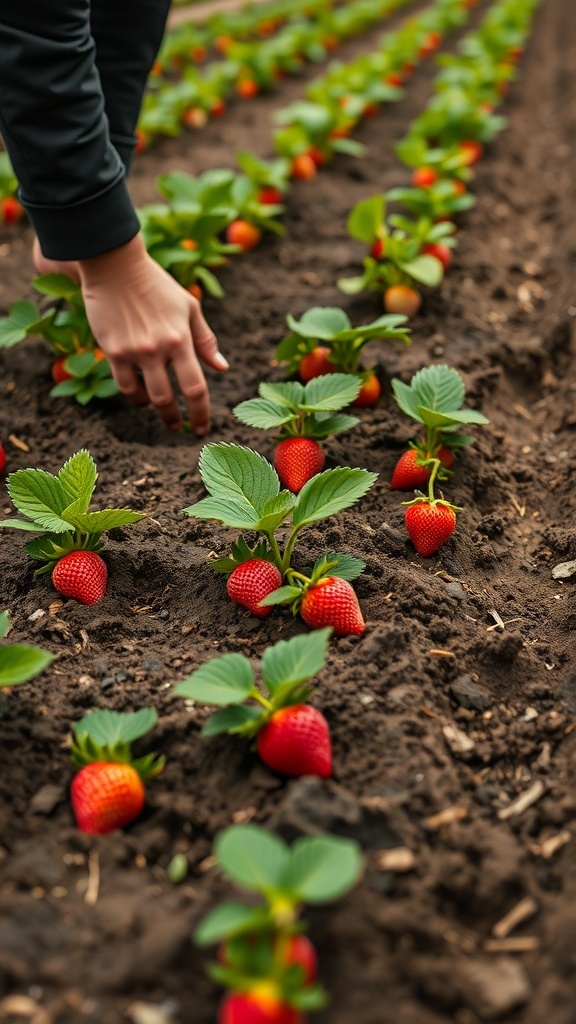
Growing strawberries can be a rewarding experience, especially when you see those vibrant red fruits ready for picking. In the image, you can see a hand gently tending to strawberry plants, ensuring they are well cared for. This hands-on approach is key to a successful harvest.
When planting strawberries, choose a sunny spot in your garden. Strawberries thrive in full sun, so aim for at least six to eight hours of sunlight each day. The soil should be well-draining and rich in organic matter. Mixing in compost can give your plants the nutrients they need.
Spacing is also important. Make sure to plant your strawberry seedlings about 12 to 18 inches apart. This allows for good air circulation and helps prevent diseases. As you can see in the image, the plants are neatly arranged in rows, which is a great way to keep things organized.
Watering is crucial, especially in the early stages. Keep the soil consistently moist but not soggy. Drip irrigation works well for strawberries, as it delivers water directly to the roots. Remember to check for pests and diseases regularly to keep your plants healthy.
Finally, don’t forget to mulch around your plants. This helps retain moisture, suppress weeds, and keep the fruit clean. With these techniques, you’ll be on your way to a bountiful strawberry harvest!
Preparing the Soil for Planting
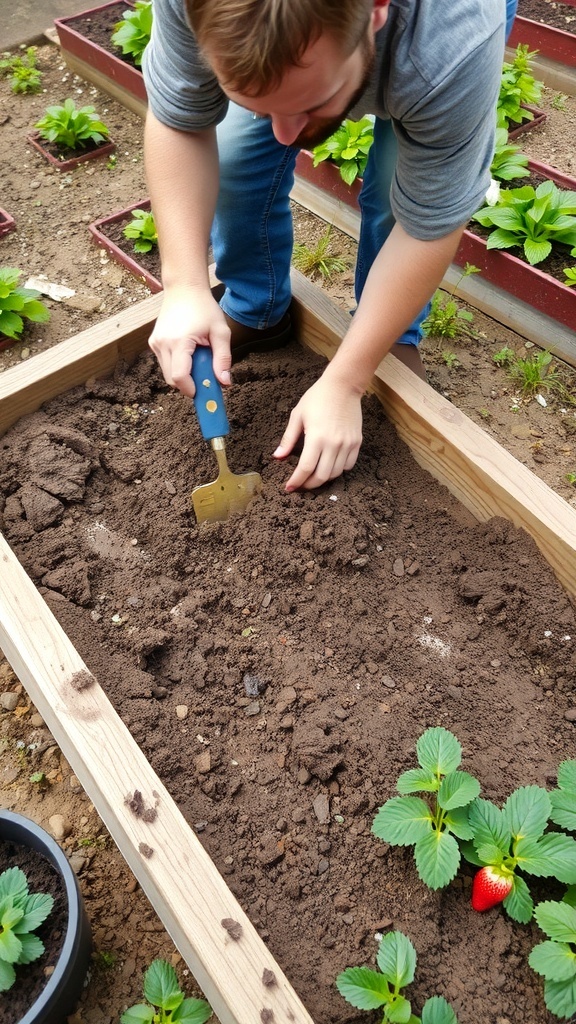
Getting your soil ready is a key step in growing a successful strawberry garden. In the image, you can see someone working diligently in a raised garden bed, ensuring the soil is just right for planting. This hands-on approach is essential for creating a healthy environment for your strawberries.
Start by clearing any debris from your garden bed. This includes rocks, weeds, and old plant material. Once the area is clean, it’s time to check the soil quality. You want it to be loose and well-draining. If it feels compacted, loosen it up with a garden fork or shovel.
Next, consider adding organic matter like compost. This enriches the soil and provides essential nutrients for your plants. Mix it in well, so the nutrients are evenly distributed. The person in the image is likely doing just that, ensuring the soil is ready to support healthy strawberry plants.
Finally, check the pH level of your soil. Strawberries thrive in slightly acidic soil, ideally between 5.5 and 6.5. You can buy a simple pH test kit at a garden store. If your soil is too alkaline, adding sulfur can help adjust the pH.
Watering and Irrigation Methods
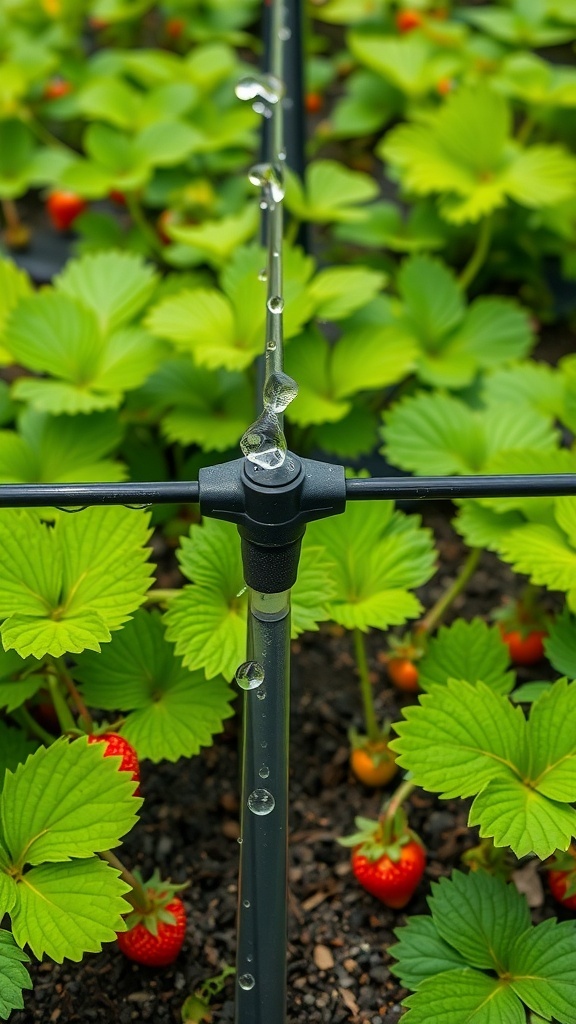
Keeping your strawberry garden healthy starts with proper watering. In the image, you can see a drip irrigation system in action. This method delivers water directly to the roots, ensuring that your plants get just what they need.
Drip irrigation is efficient and helps prevent water waste. The droplets you see forming on the tubing are a sign that water is being distributed evenly. This system not only saves water but also reduces the risk of fungal diseases by keeping the leaves dry.
When setting up your irrigation, consider the spacing of your plants. Each strawberry plant needs enough water, but overwatering can lead to root rot. Monitor the soil moisture to find the right balance.
Another option is to use soaker hoses. They work similarly to drip irrigation but are easier to install for smaller gardens. Just lay them out on the soil and let them do the work.
Remember, strawberries thrive in moist soil, but they don’t like to sit in water. Adjust your watering schedule based on the weather and the growth stage of your plants. Happy gardening!
Choosing the Right Strawberry Varieties
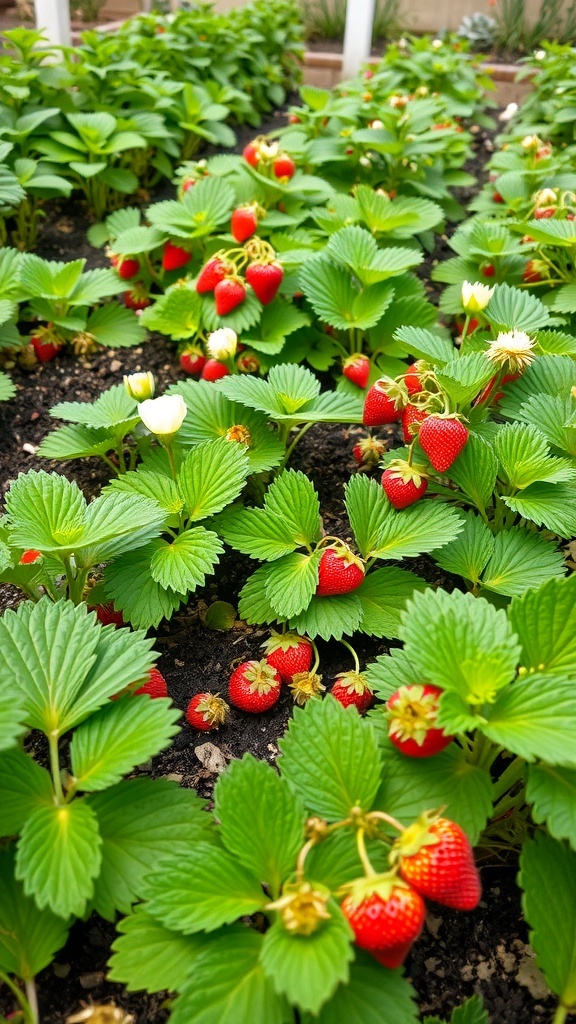
When starting your strawberry garden, picking the right varieties is key. The image shows vibrant strawberry plants, full of ripe and unripe fruit, showcasing the beauty of a well-tended garden. Each variety has its own unique flavor and growth habits, making your choice important for both taste and yield.
Some popular types include June-bearing, everbearing, and day-neutral strawberries. June-bearing varieties produce a large crop in late spring or early summer. Everbearing types yield fruit throughout the growing season, while day-neutral varieties can produce berries even in cooler weather. Think about when you want to harvest and how much space you have.
Look for varieties that thrive in your climate. Some strawberries prefer cooler temperatures, while others can handle heat. Local gardening centers often have recommendations based on your area. Don’t forget to consider disease resistance as well; some varieties are more resilient against common pests and diseases.
Lastly, think about how you plan to use your strawberries. If you want to make jams or desserts, sweeter varieties might be your best bet. For fresh eating, a mix of flavors can add excitement to your garden. Happy planting!
Fertilizing for Healthy Growth
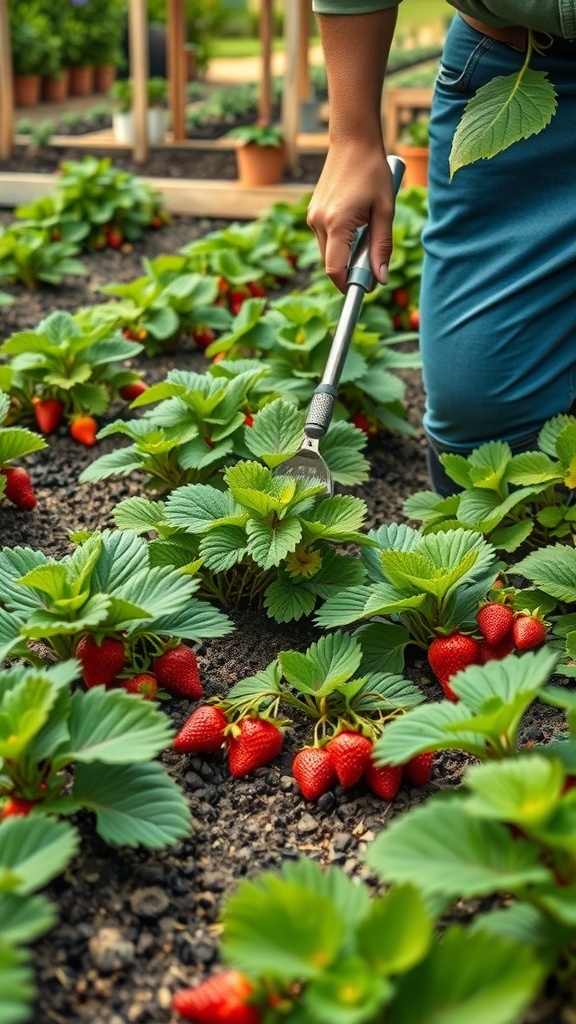
Fertilizing your strawberry garden is key to getting those juicy, sweet berries. In the image, you can see a gardener tending to vibrant strawberry plants, ready to give them the nutrients they need.
Start with a balanced fertilizer that has equal parts nitrogen, phosphorus, and potassium. This mix supports strong leaf growth and healthy fruit development. Apply it in early spring when the plants are waking up from their winter rest.
As the season progresses, you might want to add a little extra nitrogen to promote lush green leaves. Just be careful not to overdo it, as too much nitrogen can lead to more leaves and fewer strawberries.
Organic options like compost or well-rotted manure can also work wonders. They improve soil structure and provide a slow release of nutrients. Spread a layer around the base of the plants, and watch them thrive!
Don’t forget to water your plants after fertilizing. This helps the nutrients soak into the soil and reach the roots. With the right care, your strawberry garden will flourish, giving you a bountiful harvest.
Harvesting Ripe Strawberries
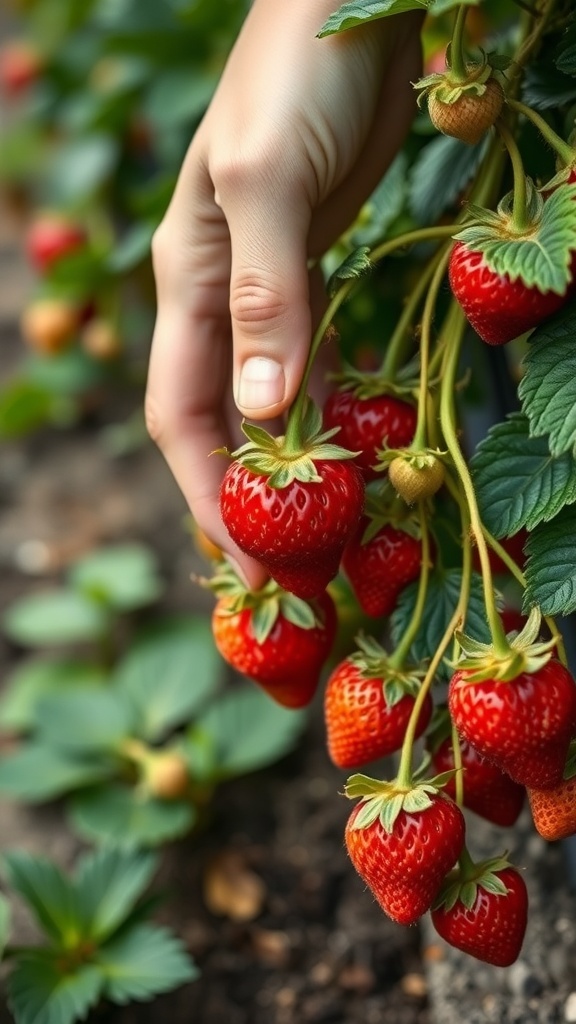
Harvesting strawberries is one of the most rewarding parts of gardening. When you see those bright red berries hanging from the plants, it’s hard not to feel excited. The image shows a hand gently picking a ripe strawberry, showcasing the perfect moment of harvest.
To know when to pick, look for strawberries that are fully red. They should feel firm and plump. If they have any green or white spots, they need more time on the vine. Gently twist or cut the stem to avoid damaging the plant.
Make sure to check your plants regularly. Strawberries can ripen quickly, especially in warm weather. Picking them at the right time ensures the best flavor. Enjoy your fresh strawberries right away or store them in the fridge for later!
Seasonal Care for Strawberry Gardens
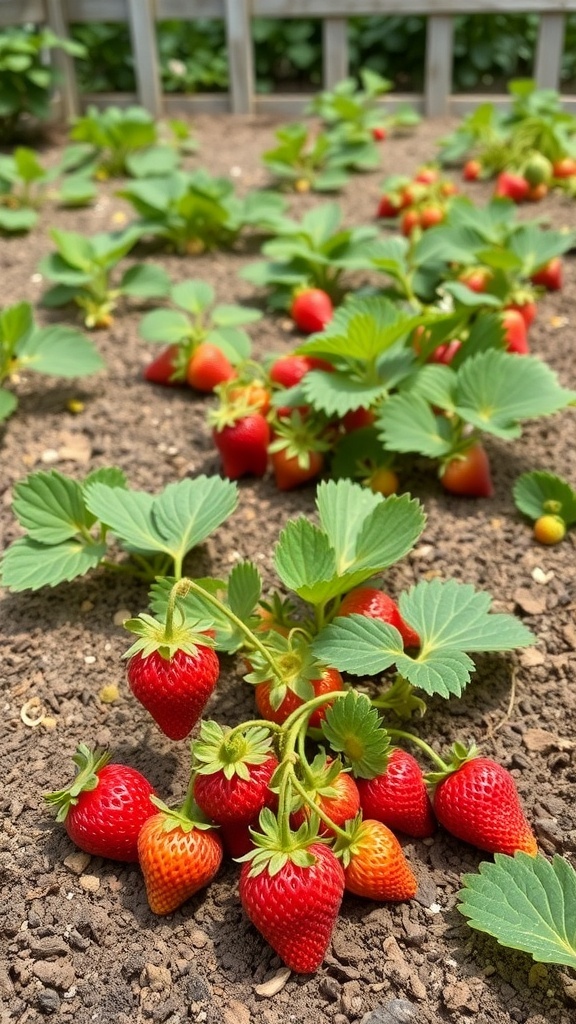
Strawberry gardens can be a delight, especially when you see those bright red berries peeking through the green leaves. In the image, you can spot several ripe strawberries nestled among the lush foliage. This vibrant scene is a reminder of the joy that comes with caring for your plants throughout the seasons.
During the growing season, it’s essential to keep your strawberry plants healthy. Regular watering is key, especially in warmer months. Strawberries thrive in well-drained soil, so make sure not to overwater. Mulching can help retain moisture and keep weeds at bay.
As the season progresses, watch for pests and diseases. Keeping an eye on your plants will help you catch any issues early. If you notice any signs of trouble, act quickly to protect your precious strawberries.
When it’s time to harvest, pick the berries when they are fully red. This is when they are at their sweetest! Enjoy them fresh, or use them in your favorite recipes. Caring for your strawberry garden can be rewarding, and the fruits of your labor are definitely worth it!
